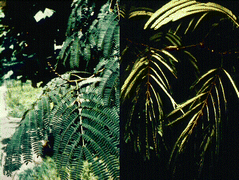Fluorescence studies on nyctinasty which suggest the existence of genus-specific receptors for leaf-movement factor
Abstract
Periodic leaf-movement of legumes is called nyctinasty and has been known since the age of Alexander the Great. We found that nyctinasty is controlled by a periodic change of the internal concentration of leaf-opening and leaf-closing substances in the plant body. Now, we have developed novel fluorescent probes (1) based on the structure of cis-p-coumaroylagmatine (3), which was isolated as a leaf-opening substance of Albizzia juribrissin Durazz. Binding experiments using probe 1 showed that Albizza plants have receptors for a leaf-opening substance in their motor cells. By using probes 1 we then found that genus-specific receptors are involved in nyctinasty.


 Please wait while we load your content...
Please wait while we load your content...